If you’re thinking of growing your own cycads at home, whether it’s to add to a prehistoric plant collection, or for an alternative to palms, it’s essential to find a reputable seller, and find cycads grown from seed and in cultivation.
Despite their challenges, cycads are rewarding, long lived plants that grow slowly in a garden, rather than adding any instant impact. For me that just adds to the joy of watching these prehistoric plants grow alongside me, and adding perpetual change as the years go by.
Follow my guide to growing cycads at home to make the most of these stunning trees and shrubs, as well as our guide to the different types of cycads to suit every space.
More...
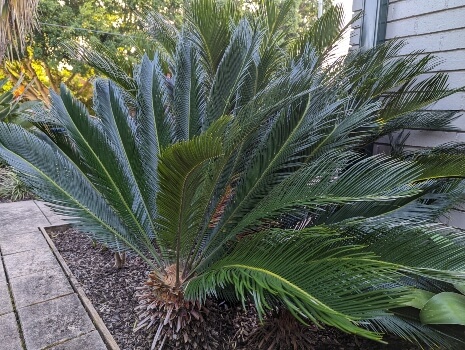
Genus: | Cycas |
|---|---|
Species: | various |
Common Names: | Cycads |
Location: | Outdoor |
Type: | Gymnosperm, evergreen trees or shrubs |
Growth: | 1-7m tall (depending on species) |
Sun requirements: | Full sun to partial shade |
Foliage Colour: | Green |
Flower Colour: | Cream, yellow or orange |
Flowering: | Summer, followed by impressive seed cones in autumn |
Fruit: | None |
Maintenance level: | Low |
Poisonous for pets: | Highly toxic to cats and dogs |
What is a Cycad?
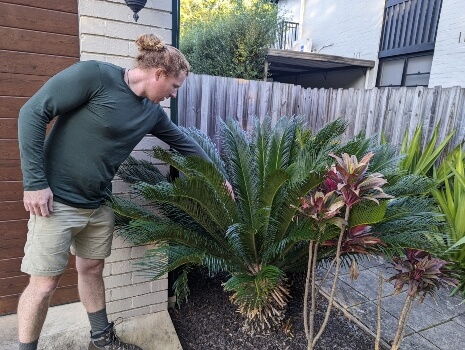
Nathan Schwartz of Aussie Green Thumb examining a Cycad Plant
Cycads are a unique and prehistoric plant group, having lived through multiple ice ages, and global mass extinctions. Despite all this, they are now at risk of extinction, almost entirely due to human interventions. In fact, several species of cycads are now thought to have fewer than 100 living specimens left in the wild.
Cycads are distinctly similar to palms, with bare, fibrous trunks, and palmate foliage spreading from their tops. However, unlike palms, their fruit and seeds are bore on upright cones, with distinct and uniquely beautiful flowers.
Cycads grow at a very slow rate, regardless of species, or ultimate height, and take a long time to properly establish in a new setting.
Cycads’ Natural Habitat
Cycads predate the continents as we know them, and now remain living in most tropical and subtropical climates. However, due to over-cultivation of forest lands, and open spaces, their habitat loss means they now live in more and more remote areas and have less connected ecosystems.
Thankfully there are many parts of Australia where it’s possible to grow healthy, happy cycads, and help to reintroduce them to our landscape, whether that’s in gardens, parks, or public spaces.
Best Cycad Varieties to Grow in Australia
There are well over 300 species of cycad recorded by botanists around the world, 81 species of cycads endemic or native to Australia, but just a handful to grow at home. Some of our absolute favourites, for indoors and outdoors are included in the list below.
1. Cycas revoluta (Sago Palm)Perhaps the best known cycad species is Cycas revoluta, known as the sago palm. Despite not bearing any genetic match to palm trees, there are so many visual likenesses that it is often used as a direct alternative in low-maintenance gardens, or indoor spaces for its slower growth and more controllable form. Other cultivars include the larger, King Sago and the slightly more compact ‘Showa’, which is ideal for indoor growers. | 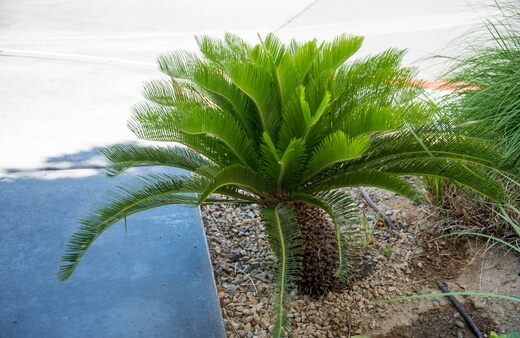 |
2. Cycas beddomeiFor quick impact, Cycas beddomei is ideal for outdoor spaces, with fast-growing foliage, which stands upright and reaches 1.5m tall within a year of planting. Its stem is slower to develop, but after a few years, you’ll have a gorgeously substantial stem, with an erect mass of foliage. | 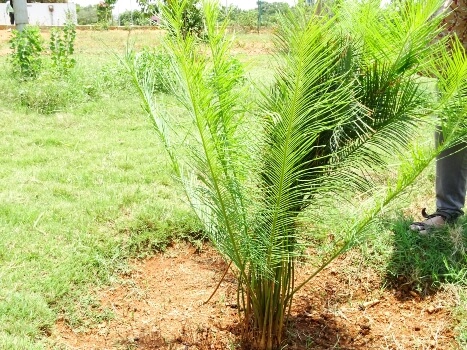 Source: Wikipedia |
3. Cycas curraniiNative to the Philippines, Cycas curranii provides an instant tropical hit with its dramatic leaves, wider, and more palmate than most species, and a considerable preference for the Australian climate which makes it really quite simple to grow in almost all gardens. | 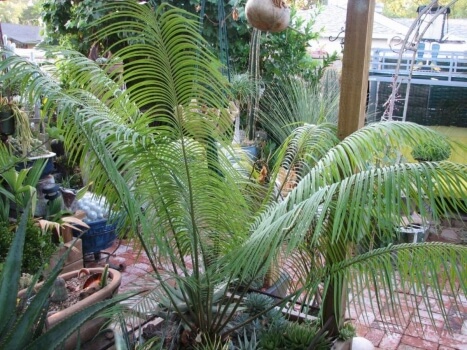 Source: Agaveville |
4. Cycas macrocarpaCycas macrocarpa, as its name suggests, has stunningly huge leaves, and copes well with topping or pollarding to promote multiple stems once it’s established properly. Its leaves shoot out from the side of the stem more dramatically than most, with very visible bare stems at the base of the leaf, making it ideal for a gentler dappled shade near a patio or veranda. | 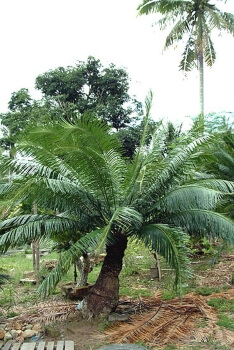 Source: PACSOA |
5. Cycas panzhihuaensisCycas panzhihuaensis should only ever be purchased from trusted sellers. They are extremely vulnerable in the wild and near extinct. They are commonly sold as Dukou sago palms. Their rarity in the wild is probably explained by their beauty, and neat form, which makes them ideal for formal gardens. | 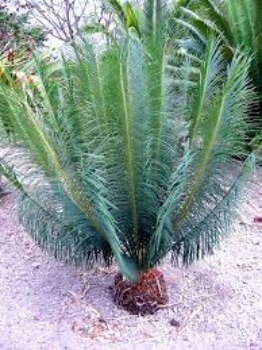 Source: Cycad Palm |
6. Cycas pranburiensisIf you were wondering just how well-drained a Cycad can be, look no further than Cycas pranburiensis, which grows naturally on rocky outcrops, with little to no moisture retention. Its thick roots hold on tight to pretty much any soil and anchor it well. While it is evergreen, it does tend to look untidy in spring when new foliage emerges, pushing old dead foliage outwards. To keep it looking tidy, cut back any old foliage as soon as new leaves emerge. | 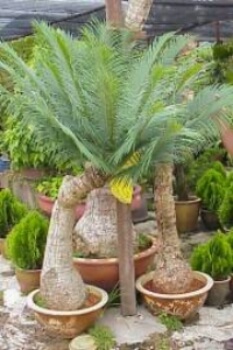 Source: Rare Palm Seed |
7. Cycas riuminianaUsually known as the Pitogo, or Arayat pitogo, these narrow-stemmed cycads are vividly similar to most species of palm tree, and are reliable flowers in summer throughout Australia. Their flowers aren’t much to write home about, but the seed cones that follow are a true natural wonder. | 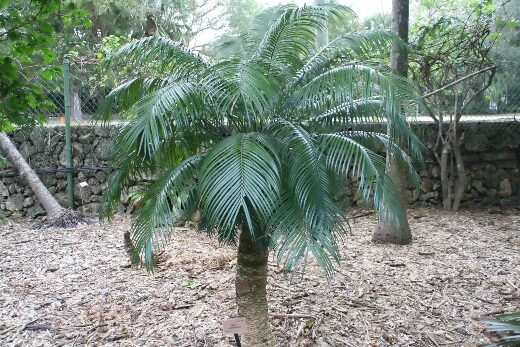 Source: Wikipedia |
8. Cycas siamensisNative to Myanmar, Thailand, and Vietnam, Cycas siamensis is a fascinating species, with a globular base to its trunk, which develops upwards, creating a conical form, topped with more flowing leaves than usual. The seed cones tend to form in large domes above the crown each year and are fascinating spectacles. | 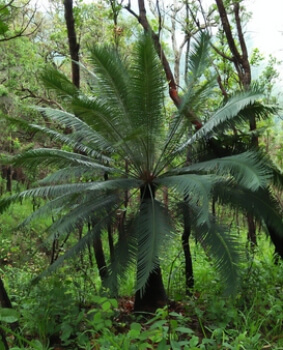 |
9. Cycas siamensis ‘Thai Silver Form’With the same iconic bulbous trunk as its parent species, Cycas ‘Thai Silver Form’ stands out from the crowd with gorgeous silvery foliage, and a wonderfully compact growing habit, making it ideal for larger indoor spaces. It’s significantly larger than typical sago palms but still worth growing indoors if you want something more impactful. | 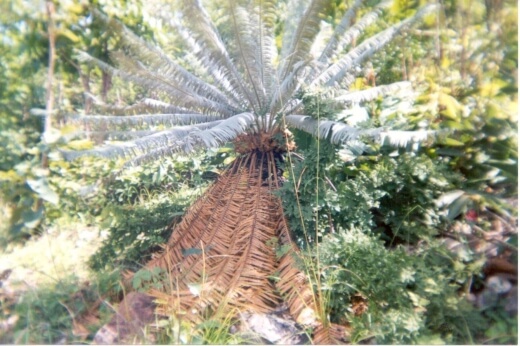 Source: Cycad Palm |
10. Cycas taitungensisGrowing up to 5m tall, Cycas taitungensis is one of the best Cycads to grow in a tropical garden. Its compact form, with gigantic leaves, makes it manageable, but still impactful. The fluffy trunk top looks similar to tree ferns but hardens as the plant matures. | 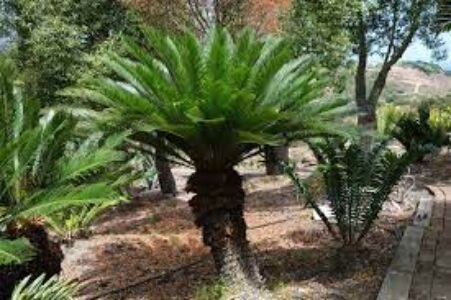 Source: Aloes in Wonderland |
Best Cycad Varieties to Grow in Australia
There are well over 300 species of cycad recorded by botanists, but just a handful to grow at home. Some of our absolute favourites, for indoors and outdoors are included in the list below.
1. Cycas revoluta (Sago Palm)

Perhaps the best known cycad species is Cycas revoluta, of the sago palm. Despite not bearing any genetic match to palm trees, there are so many visual likenesses that it is often used as a direct alternative in low-maintenance gardens, or indoor spaces for its slower growth and more controllable form.
Other cultivars include the larger, King Sago and the slightly more compact ‘Showa’, which is ideal for indoor growers.
2. Cycas beddomei

Source: Wikipedia
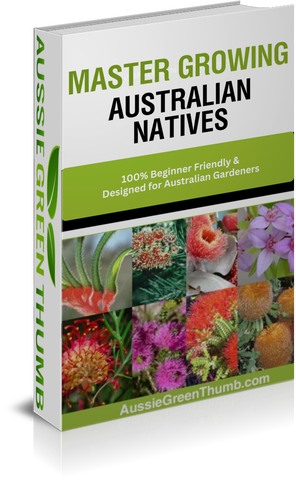

Get Your Free Guide:
Master Growing Australian Natives eBook
A Must Have Complete Guide for Every Australian Garden
Get Your Free Guide:
Master Growing Australian Natives eBook
A Must Have Complete Guide for Every Australian Garden
For quick impact, Cycas beddomei is ideal for outdoor spaces, with fast-growing foliage, which stands upright and reaches 1.5m tall within a year of planting. Its stem is slower to develop, but after a few years, you’ll have a gorgeously substantial stem, with an erect mass of foliage.
3. Cycas curranii

Source: Agaveville
Native to the Philippines, Cycas curranii provides an instant tropical hit with its dramatic leaves, wider, and more palmate than most species, and a considerable preference for the Australian climate which makes it really quite simple to grow in almost all gardens.
4. Cycas macrocarpa

Source: PACSOA
Cycas macrocarpa, as its name suggests, has stunningly huge leaves, and copes well with topping or pollarding to promote multiple stems once it’s established properly.
Its leaves shoot out from the side of the stem more dramatically than most, with very visible bare stems at the base of the leaf, making it ideal for a gentler dappled shade near a patio or veranda.
5. Cycas panzhihuaensis

Source: Cycad Palm
Cycas panzhihuaensis should only ever be purchased from trusted sellers. They are extremely vulnerable in the wild and near extinct. They are commonly sold as Dukou sago palms.
Their rarity in the wild is probably explained by their beauty, and neat form, which makes them ideal for formal gardens.
6. Cycas pranburiensis

Source: Rare Palm Seed
If you were wondering just how well-drained a Cycad can be, look no further than Cycas pranburiensis, which grows naturally on rocky outcrops, with little to no moisture retention. Its thick roots hold on tight to pretty much any soil and anchor it well.
While it is evergreen, it does tend to look untidy in spring when new foliage emerges, pushing old dead foliage outwards. To keep it looking tidy, cut back any old foliage as soon as new leaves emerge.
7. Cycas riuminiana

Source: Wikipedia
Usually known as the Pitogo, or Arayat pitogo, these narrow-stemmed cycads are vividly similar to most species of palm tree, and are reliable flowers in summer throughout Australia.
Their flowers aren’t much to write home about, but the seed cones that follow are a true natural wonder.
8. Cycas siamensis

Native to Myanmar, Thailand, and Vietnam, Cycas siamensis is a fascinating species, with a globular base to its trunk, which develops upwards, creating a conical form, topped with more flowing leaves than usual.
The seed cones tend to form in large domes above the crown each year and are fascinating spectacles.
9. Cycas siamensis ‘Thai Silver Form’

Source: Cycad Palm
With the same iconic bulbous trunk as its parent species, Cycas ‘Thai Silver Form’ stands out from the crowd with gorgeous silvery foliage, and a wonderfully compact growing habit, making it ideal for larger indoor spaces.
It’s significantly larger than typical sago palms but still worth growing indoors if you want something more impactful.
10. Cycas taitungensis

Source: Aloes in Wonderland
Growing up to 5m tall, Cycas taitungensis is one of the best Cycads to grow in a tropical garden. Its compact form, with gigantic leaves, makes it manageable, but still impactful. The fluffy trunk top looks similar to tree ferns but hardens as the plant matures.
Types of Australian Cycads
There are 81 species of cycads endemic or native to Australia, falling into four genera, and two families. While Cycads are spread globally, with some genera limited to South America or South Africa, our own shores are host to dozens of unique and beautiful cycads.
Some of our native genera are more widespread, but one of two genera are entirely limited to Australia, not just as their native range, but also as their sole habitat, either in nature or cultivation, making them extremely rare plants, and worth protecting as well as admiring.
The four genera of cycads, native to Australia, grouped into their two respective families are:
- Cycadaceae
- Cycas
- Zamiaceae
- Macrozamia
- Lepidozamia
- Bowenia
Cycads in the Cycas genus (the only genus in the Cycadaceae family)
The Cycas genus is widespread, with around a hundred species spread throughout Asia and Australia, with one species found native in Madagascar. Of the thirty-six Cycas species native to Australia, the majority are Queensland natives, with just a few found in the Northern Territory or Western Australia.
While no cycads are native to southern or central parts of Australia, most can be grown in gardens with good planting conditions.
Below is a list of all 36 native Cycas species in Australia, with a note for each on its native range:
- Cycas yorkiana – native to Cape York Peninsula, Queensland,
- Cycas xipholepis – native to Cape York Peninsula, Queensland
- Cycas tuckeri – native to Cape York Peninsula, Queensland
- Cycas terryana – native to central Queensland
- Cycas scratchleyana – native to Queensland and New Guinea
- Cycas pruinosa – native to Kimberley, Western Australia & Spirit Hills, Northern Territory
- Cycas lane-poolei – native to Kimberley, Western Australia
- Cycas furfuracea – native to Western Australia
- Cycas distans – native to Queensland (savannah)
- Cycas desolata – native to Queensland
- Cycas cupida – native to Queensland
- Cycas candida – native to Queensland
- Cycas brunnea – native to the Northern Territory, northwest Queensland, and wide spread in northern Australia
- Cycas badensis – native to Badu Island and Torres Strait Islands, northern Queensland
- Cycas arnhemica – native to Arnhem Land, Northern Territory
- Cycas platyphylla – native to Atherton Tableland, Queensland
- Cycas ophiolitica – native to Queensland
- Cycas couttsiana – native to Queensland
- Cycas angulata – native to northeastern Northern Territory, northwest Queensland, and Bountiful Islands
- Cycas conferta – native to Kakadu National Park, Northern Territory
- Cycas canalis – native to Channel Point & the Daly River, northwest Northern Territory
- Cycas orientis – native to Eastern Arnhem Land, Northern Territory
- Cycas semota – native to Cape York Peninsula Queensland
- Cycas basaltica – native to Kimberley, Western Australia
- Cycas silvestris – native to Cape York Peninsula, Queensland
- Cycas arenicola – native to the East Alligator River basin, Northern Territory
- Cycas maconochiei (and below subspecies) – native to Northern Territory
- Cycas maconochiei ssp. maconochiei – native to Northern Territory
- Cycas maconochiei ssp. lanata – native to Northern Territory
- Cycas maconochiei ssp. viridis – native to Northern Territory
- Cycas armstrongii – native to Northern Territory
- Cycas calcicola – native to northwest Northern Territory
- Cycas megacarpa – native to Queensland
- Cycas cairnsiana – native to Newcastle, northern Queensland
- Cycas media – native to Queensland, Northern Territory & Western Australia
- Cycas rumphii – native to Christmas Island
Cycads in the Bowenia genus (part of the Zamiaceae family)
There are just two species in the limited genus Bowenia, and both are native to and only found growing natively in Queensland, Australia. Neither are true Cycads, but they are both commonly referred to as ‘cycad ferns’, and can be found growing in low-lying tropical forests, beneath marginal Acacias.
- Bowenia serrulata (the ‘Byfield Fern’) – native to Byfield, Queensland
- Bowenia spectabilis – native to the lowland tropical forests of Queensland
Cycads in the Lepidozamia genus (part of the Zamiaceae family)
Lepidozamia is another Australian native genus, with just two species to its name. Both species are cycads, and have distinctly waxy leaves that are clearly distinct from any other genus grouped as Cycads.
Both are native to rainforest climates and have very apparent scale-like structures leading from the stem to their leaves.
- Lepidozamia hopei – native to northern Queensland
- Lepidozamia peroffskyana – native to southeastern Queensland and northeastern New South Wales
Cycads in the Macrozamia genus (part of the Zamiaceae family)
There are 41 species in the genus Macrozamia, and each one is native to Australia and Australia alone. One species, Macrozamia denisonii, is a synonym for Lepidozamia peroffskyana, potentially bringing the list to 42.
The native range of Macrozamia varies but tends to be dry subtropical or tropical forests, with most found growing wild in limited pockets of Queensland.
- Macrozamia cardiacensis – native to southeast Queensland
- Macrozamia communis – native to the east and south coast of New South Wales, and inland near the Mudgee district
- Macrozamia concinna – native to New South Wales
- Macrozamia conferta – native to southeast Queensland
- Macrozamia cranei – native to southeast Queensland
- Macrozamia crassifolia – native to southeast Queensland
- Macrozamia diplomera – native to New South Wales
- Macrozamia douglasii – native to southeast Queensland
- Macrozamia dyeri – native to the southern coast of Western Australia
- Macrozamia elegans – native to the Blue Mountains, New South Wales
- Macrozamia fawcettii – native to New South Wales
- Macrozamia fearnsidei – native to southeast Queensland
- Macrozamia flexuosa – native to New South Wales
- Macrozamia fraseri – native to the Swan Coastal Plain & Geraldton Sandplains, southwestern Western Australia
- Macrozamia glaucophylla – native to New South Wales
- Macrozamia heteromera – native to northwestern New South Wales
- Macrozamia humilis – native to Inverell, New South Wales
- Macrozamia johnsonii – native to New South Wales
- Macrozamia lomandroides – native to the tropical and subtropical dry forests of southeast Queensland
- Macrozamia longispina – native to southeast Queensland
- Macrozamia lucida – native to southeast Queensland
- Macrozamia macdonnellii – native to the Macdonnell Ranges, Northern Territory
- Macrozamia machinii – native to Inglewood, Queensland
- Macrozamia macleayi – native to Queensland
- Macrozamia miquelii – native to southeast and central Queensland, New South Wales, and Eastern Australia
- Macrozamia montana – native to New South Wales
- Macrozamia moorei – native to southeast and central Queensland
- Macrozamia mountperriensis – native to Mount Perry in southeast Queensland
- Macrozamia occidua – native to the dry forests of southeast Queensland
- Macrozamia parcifolia – native to southeast Queensland
- Macrozamia pauli-guilielmi – native to southeast Queensland, northeast New South Wales
- Macrozamia platyrhachis – native to southeast Queensland
- Macrozamia plurinervia – native to southeast Queensland and northeast New South Wales
- Macrozamia polymorpha – native to New South Wales
- Macrozamia reducta – native to New South Wales
- Macrozamia riedlei – native to southwestern Western Australia
- Macrozamia secunda – native to New South Wales
- Macrozamia serpentina – native to southeast Queensland
- Macrozamia spiralis – native to New South Wales
- Macrozamia stenomera – native to New South Wales
- Macrozamia viridis – native to southeast Queensland
How to Grow Cycads in Australia
Nearly all cycad species prefer warm but moist climates in full sun, but there are a few, particularly low-growing varieties, that grow well through droughts, or even in shade.
To factor in the difference in growing conditions, we’ve stuck to the most general treatment of cycads, but for specific species, see our notes above against some of the most popular varieties.
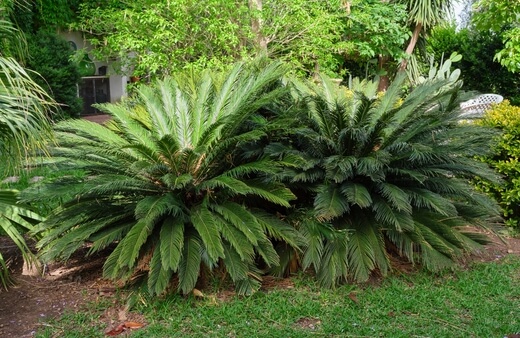
Ideal Conditions for Growing Cycads Outdoors
Cycads are large plants, so if you do decide to grow one as a houseplant, eventually it will have to make its way outdoors. If you live in part of Australia where it’s ok to plant young cycads outside (tropical or subtropical regions), I would strongly advise planting them straight outdoors from day one.
How and Where to Plant Cycads Outdoors
Cycads like full sun, but can cope in part shade. Their roots aren’t invasive, which means they can be planted pretty close to permanent structures, but do try to factor in their eventual spread to make the most of their beautiful canopy.
Cycad roots are fleshy and grow downwards and laterally in fairly equal measure, so when you do come to plant them, make sure the planting hole is twice the width, and twice the depth of the pot they are already in.
This will aid drainage, and help their roots to establish. Before planting, tease any winding roots away from the root ball, and gently rub over any fibrous roots to encourage new lateral growth.
Soil and Drainage
Cycads aren’t picky when it comes to pH or nutrient levels, and are very well adapted to grow on poor or competitive soil, however, it is important that their soil is well drained, so water is never sitting around the base of the plant.
Prepare sandy soils by adding some organic compost to enrich the soil, and provide better purchase. For clay soils mix in plenty of grit, vermiculite, or sand to improve drainage.
If your soil is completely depleted and void of any nutrients add a dry, granular fertiliser after planting for slow-release nutrients over the first season.
Light and Temperature
Cycads can cope with light shade, but need bright conditions, and should ideally be planted in full sun with around 6-8 hours of direct light per day. In cooler parts of Australia, with higher rainfall, aim for more exposed spots, with plenty of direct light.
For warmer parts of the country with droughts expected through summer, plant cycads with some light afternoon shade.
Temperature is probably the most important consideration for cycads, and it’s crucial to choose the right variety. Most cycads will survive temperatures down to -5°C, but when it drops below 15°C they begin to lose their leaves and should be treated as deciduous, rather than evergreen.
In cooler parts of the country with prolonged periods below 10°C, it’s worth bringing cycads inside to avoid overly stressing the plant.
Watering Cycads
Cycads need good drainage. Many species are actually happy to grow in almost arid conditions, with very minimal rainfall so preparing well-drained soil and forgoing any water or mulch through winter is essential.
How to Grow Cycads Indoors
Cycads, particularly smaller species like the Sago Palm (Cycas revoluta) grow well indoors and benefit from more controlled temperatures. While many species of cycad are too large to grow indoors there are tons of prehistoric species which are perfect for containers.
Choose a container that is about 2” wider than the roots, and about twice the depth of the current root ball. This allows for downward root growth, which will help to prevent root rots, and also make more of a feature of the trunk.
Fill the container with a free-draining potting mix that’s still capable of holding some water (Cactus potting mixes are ideal), and do not firm your plant in, let the water do this for you to prevent compaction and encourage faster root development.
Guide to Propagating Cycads
By far the easiest way to propagate cycads is from seed, but that requires something that can be pretty hard to come by, and a lot of waiting; seeds. If you want to get ahead and try to duplicate your cycads right now, taking cuttings, or replanting pups is slow but rewarding.
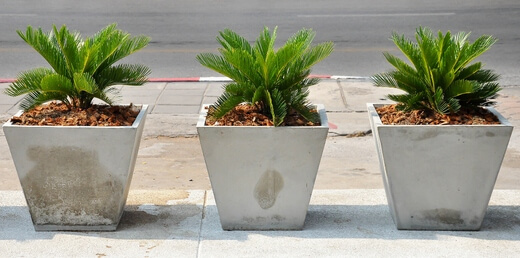
How to Propagate Cycads from Seeds
If you can get hold of cycad seeds, they are reliable to germinate and require very little care. The first thing you’ll notice is the size of the seeds; they’re huge! After that, there’s very little else you need to do to prepare them.
Simply place them on the surface of a coir potting mix, or compost mixed with at least 50% perlite, in a standard seed tray, and keep them moist. Position the tray in bright, warm conditions, away from direct afternoon sun.
After about a month, you’ll have new shoots from each seed, and when they get large enough to handle, with good roots, it’s time to pot on. Gently prize each seed from the tray, keeping the roots intact, and ideally, a small amount of compost with it.
Plant it into a similar potting mix, in an individual pot, about twice the width and depth of the seed. Bury the seed so the top is just poking out the soil, and water it well. Leave it in a bright position, somewhere warm, and care for it as you would a mature plant.
Propagating Cycads from Cuttings
Cycad cuttings are tricky, and should only be taken from mature plants that can handle the removal of old buds. They also take a while to show signs of life.
To take a cycad cutting, you will need:
- A mature cycad
- Sandy potting mix (50% sand, 50% spent compost)
- Seed tray
- A sharp knife or curved cutting knife
- Rooting hormone - indole-3-butyric acid (IBA) based hormones are best
To take cycad cuttings:
- Start by preparing your container.
- Fill a seed tray with 50% sand and 50% spent compost, or any inert potting medium (composted coir works).
- Identify an old bud on the trunk (where leaves used to be).
- These buds are packed with hormones and can be coaxed into developing their own roots.
- Carefully insert a knife underneath the bud, and cut away a tiny section at the base so you’re left with an intact bud and a small section of its base.
- Dip the end into the rooting hormone, and then place it into the sandy potting mix.
- Water the surface well, and then leave it somewhere warm and bright but away from any direct sunlight.
- After 2-3 months there should be some signs of life beginning to appear.
- After that, you can start gradually increasing light exposure, and working towards treating each cutting as an individual plant once it develops its true leaves.
Cycad Propagation from Pups
I’ve never been lucky enough to have my cycads produce pups, but it is possible and even common in some climates. If you see tiny cycads popping up around your original plant, it’s well worth teasing them out of the soil and cutting away a section of root to go with them.
The process is simple, and as long as you take the pup, and its accompanying root section, you can pot it straight into a well-drained potting medium to create new plants instantly.
Caring for Cycads
Cycads are heavy nitrogen feeders while they are young. Once they establish in a container or in the ground, they reduce their nutrient needs and care becomes much less dutiful. Nearly all of our cycad care tips are based around this single need for nitrogen while young.
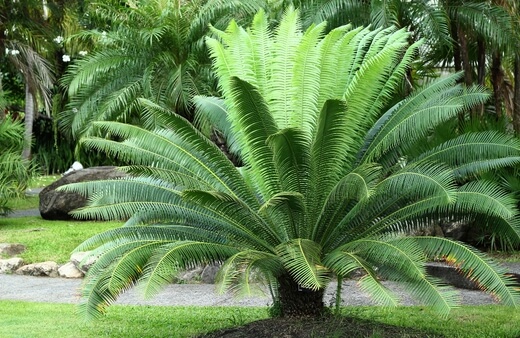
Mulching Cycads
One of the most readily available mulches in most gardens is grass clippings. Grass clippings break down quickly and have easily available nitrogen for soil bacteria, worms, beetles, and other insects to break down.
In spring, when the weather begins to warm up, apply a liberal layer of grass clippings, leaving an inch of free space not touching the trunk. Avoid using flowering grass, or grass that has gone to seed as these can cause turf to grow around the base of the cycad, which is both an extra chore to manage, and competition for young plants.
What Fertiliser to Use
For indoor cycads, any balanced houseplant feed will do the job, but aim for something with a touch more nitrogen (check for NPK numbers of the bottle, usually labelled as 10-10-10 or similar, where the first number indicates nitrogen percentage).
Pruning and Repotting Cycads
Cycads are evergreen so require no ongoing pruning. Once established, it is possible to create multi-stemmed cycads, but they will often suffer from stress as each trunk will instinctively try to create a full-sized canopy, while relying on a single root ball, so I wouldn’t personally recommend it.
If your cycads are in containers, they rarely need repotting, but when their trunks grow to within 1 inch of the walls of their container, it’s worth giving them a little bit of extra space.
Cycads Pests and Diseases
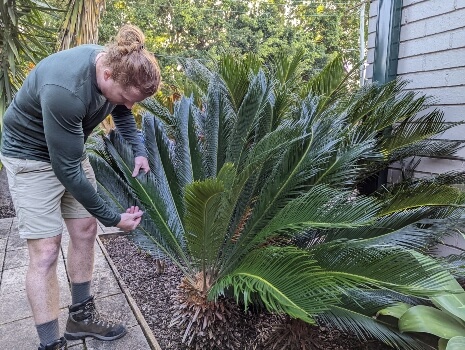
Nathan Schwartz of Aussie Green Thumb checking a Cycad's leaf
In truth, there are so few truly damaging cycad pests that it’s barely worth mentioning. Remember, these plants have survived ice ages and mass global warming events.
However, like all plants grown indoors, there is a chance of scale, mealy bug, and aphids developing due to a lack of other options. If you notice them, simply spray them off, or wipe the leaves clean with rubbing alcohol (rinse after ten minutes to stop foliage drying out).
Outdoor cycads do have one common foe; the cycad moth. The cycad moth, which is actually a dull blue butterfly, lays eggs amongst newly developing foliage.
Its caterpillars proceed to feed on the young, softer foliage, causing yellow or dropping leaves as summer goes on. Remove these leaves, and check for signs of caterpillars.
Again, it takes a lot to kill a cycad, but root rot is a particularly common problem. We mentioned earlier that drainage was key, and we weren’t kidding. Poorly drained cycads, despite their overall resilience, are incredibly susceptible to root rot for nearly all common root funguses.
If you notice dry-looking foliage paired with damp soil, root rot is the most likely cause. Stopping watering for a few weeks might help the problem to clear up, but if not, dig up the plant, trim out any damaged roots, and dead foliage, and re-pot the whole thing, with rinsed roots, into new soil.
Cycads Frequently Asked Questions

Why are cycads so expensive?
Cycads are under threat of extinction in the wild due to habitat loss, and over-harvesting for horticultural trades. They have very little use for food or any human resource, so their harvesting is entirely down to the over-exuberance of plant explorers.
Today, this means that all cycads are grown from cultivated seeds, and the market is strictly regulated.
Can you take wild cycad seeds for propagation?
You should never take cycad seeds, cuttings, or plants from the wild. They are under threat of extinction, and should never be taken out of their natural habitat.
Seeds should be allowed to fall naturally where they have a greater chance to develop into mature plants alongside their parents, sharing nutrients, nitrogen, and carbon through root networks in the soil.
Are cycads illegal?
While harvesting wild cycads is illegal, there are dozens of online sites and garden centres that sell responsibly grown cycads, cultivated from domestic or farmed plants. These plants are completely legal to purchase and care for.
Are cycads toxic?
All parts of cycads are toxic to humans and most animals. Their seeds cause gastrointestinal cramps, nausea, and vomiting. If consumed in excess they are known to cause liver damage and even death.
Wrapping Up Our Cycads Growing Guide
For keen plant collectors, cycads are a must-have and always have been. Sadly, this has meant the destruction of their natural habitats, root networks, and left wild plants open to unnatural threats. Thankfully, their sale is now regulated, so any cycad you find for sale should be listed from responsible sources.
If you’re serious about growing these prehistoric plants at home, or in your garden, just follow our guide above for everything you need to know about caring for, planting, and growing cycads in Australia.
Published on December 2, 2023 by Gary Clarke
Last Updated on January 21, 2024

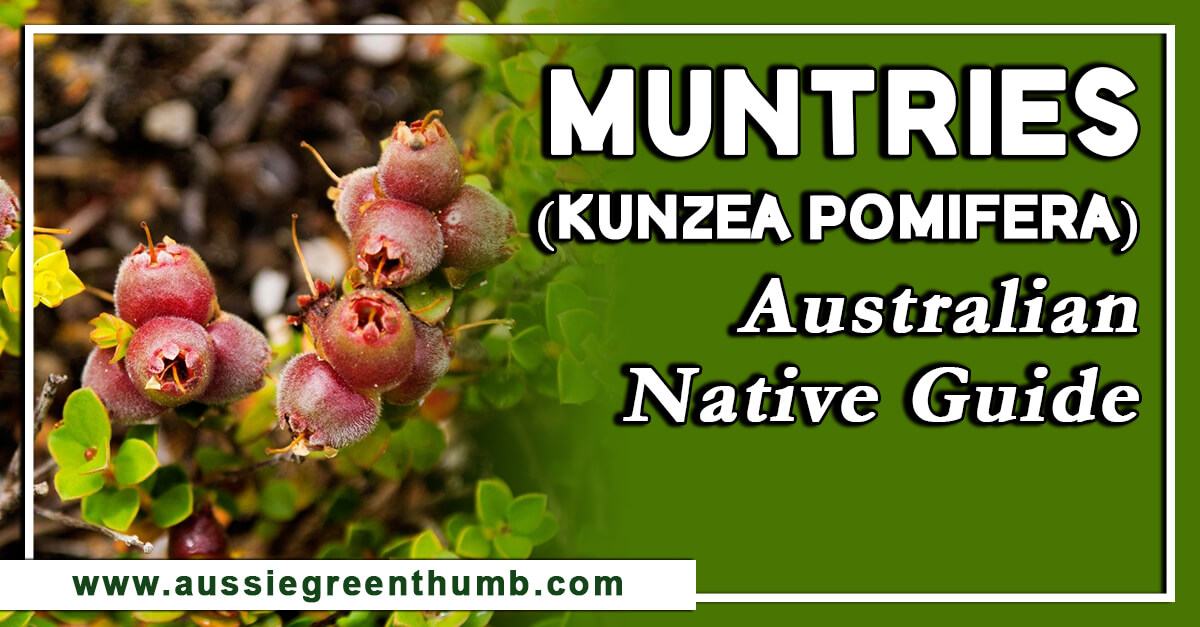
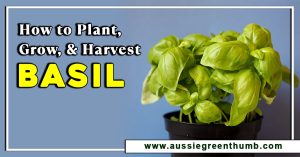
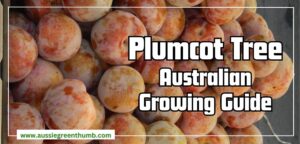
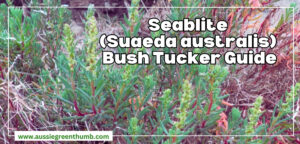
I've been told that my outdoor cycas palm is "crowning" and the crown needs to be cut out.
I'm not sure of this term as I'm not seeing it in your article.
In any case, the plant is not and has not put out new leaves/frons for some time. Growth shoots from the center, but doesn't green up or produce.
The center "crown" is about 8cm in height now.
Please give your advice.
Hi Tara,
The answer depends on what you mean by ‘for some time’. If that’s for the last season, or over winter, it’s pretty normal. Does your cycad still have its old leaves? If they’re browning, or have fallen off, it’s probably some form of crown rot, or root rot causing stagnating growth.
If they’re completely brown, then it could be a cycad moth.
If your cycad leaves are still healthy and green, the central growth might be its flower or fruit starting (it’s a slow process, but worth waiting for just because it’s a pretty spectacular part of earth’s biological history).
As far as I’m aware, there’s no specific problem relating to cycads called “crowning”, but there are some references online to it with pictures that show new fronds tightly packed and failing to open. I’ve never seen it in person, but I’ve seen something similar on ferns and dahlia flowers, usually caused by secretions from pests or mineral excess.
Essentially it’s a build-up of something (anything) sticky that forms a net around the new petals or fronds, and stops them from opening.
If that’s the case, and it’s a big ‘if, then it will look sort of onion shaped, and you might be able to peel emerging fronds out from the centre, which will allow new ones to develop unencumbered.
And finally, don’t worry too much. Unless there are signs of rot, it’s pretty difficult to kill a cycad. They’ve lived through ice ages and mass global extinctions!
Best regards,
Gary Clarke
Hi, Ive had a potted Cycad for over 30 years and repotted once. It still looks great but i have found that they will sunburn in an Adelaide summer so I tend to keep it under shade cloth or dappled tree canopy light . I also have a couple of others which are the more like the Sago palm type also potted and seem to do well. Again I have to keep them away from the summer sun to stop burning.They are a great low maintenance plant.
Hi Ron,
That’s amazing! Keeping them under shade cloth or dappled light is definitely a smart move to prevent sunburn, especially in Adelaide’s summer heat.
It’s awesome to hear that they’ve thrived under your care for over 30 years. Do you have any other tips or tricks for keeping Cycads healthy?
Best regards,
Gary Clarke